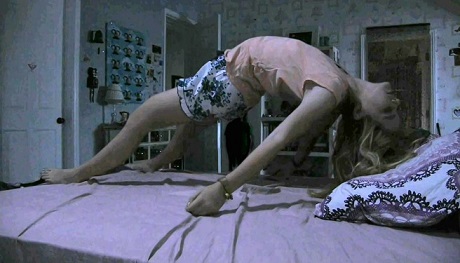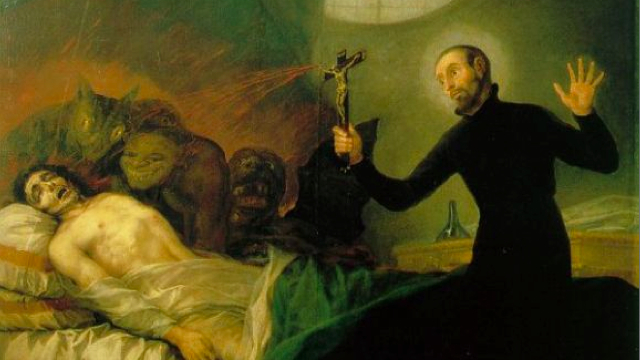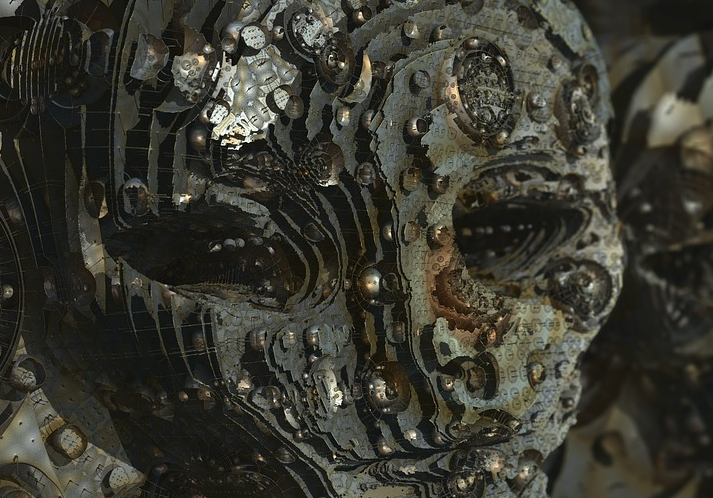That the idea of demonic possession is closely associated with religion is no great revelation.
(Article by Stewart James Felker)
Among the earliest historical evidence for the idea of demonic possession that we have comes from ancient Mesopotamian texts, where a variety of illnesses and conditions were seen through the lens of various regional religions and mythologies, and their accompanying demonologies.

A depiction of opisthotonus in a person with tetanus, by Sir Charles Bell (1809). Source: WikiMedia Commons
And, undoubtedly, it’s some of the very same ancient Near Eastern ideas and traditions on demons that exercised a strong influence on Israelite/Jewish religion and demonology. In turn, this set the background for Christianity, where Jesus’ battle with the demonic realm occupies an important part of his ministry as it’s portrayed in the New Testament and elsewhere—which, from here, left a lasting impression on Western civilization.
If that’s a bit of the historical dimension of the intersection between possession and religion and how it came to prominence in the Western world, then this has been carried over into present as well; and it seems that religion plays an important role at each step along the way in the “diagnosis” of demonic possession.
Again, it may seem obvious to state that the concept of demonic possession is a manifestly supernatural one, and that for a great number of people, the supernatural itself is seen primarily through a religious lens.
More specifically though: if for these people, possession is the disease, then religion is the cure. And this has both preventative and curative aspects. Amulets or other folk practices are used to protect against drawing the attention of demons in the first place; blessings and holy water are used; and, naturally, in the most severe of cases, there’s exorcism—the ritual to actually expel demons from those who are thought to have become possessed.
All I really want to do in this post is to make a couple of suggestions for a kind of research program on the phenomenon of possession—a program that, in my view, continues to be neglected in many ways.
As always, my main academic interest is in early Judaism and Christianity. And in this regard, if it’s the case that Jesus¹ was, again, in major ways occupied with the demonic realm—as the Church, following his lead, has been over the past ~2,000 years, too—then demonic possession might be thought to be an essential part of Christianity, and will always remain so. (At least as long as Christianity itself continues to be studied and/or believed to be true.)
There should be little controversy in this.
But here I also want to suggest that skeptics, atheists, and the general non-religious—at least those who are interested in the behavioral and medical sciences—should take “demonic possession” more seriously than they have thus far.
I put “demonic possession” in quotes because, again, in the strict sense the concept itself is irreducibly supernatural; and as such I’m generally skeptical. But whether the origin of the phenomena associated with possession is supernatural or not, there’s certainly good reason to think that the phenomena themselves are real.
At this point we’re probably all familiar with the popular tropes of demonic possession. And to be sure, some of these are clearly supernatural or otherwise physically impossible. Think 360° head rotation, climbing up walls, speaking in fully-formed Aramaic,² levitating and such.
Of course, the relationship between these things and actual clinically-observed phenomena is unclear. Besides the fact that the popularity of several of these tropes is to be traced to their origin or portrayal in fictional movies and other media, another problem for believers in demonic possession is that reports of these phenomena are often frustratingly second- or third-hand; and as such are prone to unreliability for various reasons.³
But even if we’re talking about first-hand reports of purported demonic possession, even here there’s potential for misinterpretation. And it’s here that I want to draw attention to some of the more common “symptoms” associated with supposed demonic possession and how these might be better understood.
As examples of stock tropes of demonic possession as appear in movies and in the popular imagination, I mentioned “360° head rotation, climbing up walls, speaking in fully-formed Aramaic, and levitating.”
And, again, although in the strict sense these are all impossible, I suspect that the first and last of these—head rotation and levitation—might bear at least some relation to symptoms that appear in less fictional reports of demonic possession. That is, that these fictionalized versions could have arisen as exaggerations of actual reported phenomena.
For example, we could connect unusual and drastic body movements with a kind of dystonia or dyskinesia,⁴ or “hyperkinetic” movement disorder, which encompasses everything from mild muscle spasms to severe body contortions. In particular, in a popular portrayal of demonic possession, there’s a certain posture/contortion—often times occurring leading up to full levitation—that bears a striking resemblance to similar movements observed in those with opisthotonus, as pictured at the head of this post.

From a scene from Paranormal Activity 4, Paramount Pictures, Again, compare the picture at the head of this post.
In a section on the Garabandal apparitions in Nickell’s Looking for a Miracle: Weeping Icons, Relics, Stigmata, Visions & Healing Cures, we read
Many other alleged paranormal or supernatural occurrences, which lasted at Garabandal into 1965, cannot now be verified. These include the claim that the girls would sometimes fall to the ground, becoming so heavy that others could not lift them; that from this same position Conchita would sometimes lift her shoulders “as though she were beginning to levitate” (183)
Perhaps most importantly here, though, dyskinesia has been associated with psychosis. (1, 2, 3.)
I had also mentioned “speaking in fully-formed Aramaic.”
Of course, Aramaic itself has a particular religious significance in Christianity, as it was the native language of the historical Jesus—as does Hebrew as well, the language of the Old Testament. Right off the bat though, it might be noted that there are very few fluent speakers of Neo-Aramaic and Hebrew outside of particular regions of the Middle/Near East; and as such, claims of someone speaking in these Biblical languages are hard to verify.
That is to say that, to the untrained ear—and especially in an otherwise spiritually-charged atmosphere (compare also the sort of glossolalia that modern Pentecostals and charismatics practice)—it might be easy to believe that someone has spoken in one of these holy languages, when in reality their utterances might be no more authentic than the gibberish Hebrew of the Greek magical papyri. (Incidentally, these sorts of things in the Greek magical papyri might be the closest parallel to the glossolalia practiced by the early Christians, e.g. as mentioned by the apostle Paul.)
While on the subject of apparent speech in a foreign language, it might also be mentioned that, recently, the phenomenon of spontaneous speech in a foreign accent has received a lot attention—especially when this occurs following some sort of severe medical or neurological trauma.
Foreign accent syndrome, as it’s been dubbed, is usually classified as a type of unusual dysprosody, a broader category under which numerous types of unusual vocal emanations or irregularities in speech are included.
Interestingly, one of these vocal irregularities is an unusual alteration in pitch. And I think this can rather easily be connected with another motif commonly associated with demonic possession: a lowered or otherwise abnormal tone, which is usually imagined to be the voice of the demon itself, speaking “through” the person as it were.
While dysprosody and, in particular, foreign accent syndrome are more commonly understood as neurogenic—that is, occurring as the result of some sort of serious neurological damage or trauma—it’s also been increasingly recognized that it can be psychogenic, as well (1, 2, 3): arising from “an underlying psychological or psychiatric disorder such as psychosis, conversion disorder, bipolar disorder, or schizophrenia with ongoing episodes but without identifiable [trauma or structural damage].”⁵
Finally, if purported demonic possession is also frequently associated with severe screaming and shrieking—and, similar to the other alterations in tone, etc., mentioned above, we might also say dysprosodic shrieking/screaming—this is of course a classic characteristic of psychotic episodes.
I mentioned above that the dysprosody in supposed demonic possession is often understood to be the voice of the actual demon coming through its human host.
In this regard, I think it’d also be interesting to figure out in how many of these episodes the person not only speaks in the guise/voice of a demon, but also, in the course of this, talks about its human “host” in the third person.
This is reported commonly enough to qualify as a stock trope of possession; and combined with what’s been said so far, I think we can fairly say that this might all suggest a more general kind of depersonalization that occurs in these episodes. (McCasland, in his book By the Finger of God: Demon Possession and Exorcism in Early Christianity in the Light of Modern Views of Mental Illness, refers to this depersonalization as “the most decisive mark of demon possession.”)
Again though, talking in the third person about oneself—obviously not just in the quirky way that you or I might occasionally do so, but in a serious way as if one truly assumes the guise and voice of someone else—has been associated with mental disorders, especially dissociative ones. (Numerous sources here.)
In the last few sections of this post, I’ve been connecting commonly reported symptoms and phenomena associated with purported demonic possession with similar things that have been reported in the mainstream academic literature relating to psychotic and dissociative disorders and episodes.
To kind of get back to some of what I mentioned in section before this, though: a few months ago there was an article on demonic possession that appeared in the Washington Post, written by a Richard Gallagher, professor of clinical psychiatry at New York Medical College.
He begins by recounting how, in the late 80s, he was called to consult with Catholic priests about a case of purported demon possession.
To be sure, Gallagher ascribes to this patient several of the things I’ve touched upon throughout my post, including her spontaneously speaking in a Biblical language—though again, this is recounted on the basis of second-hand reports: “[s]ix people later vouched to me that, during her exorcisms, they heard her speaking multiple languages, including Latin, completely unfamiliar to her outside of her trances.”
He also suggests that
my subject’s behavior exceeded what I could explain with my training. She could tell some people their secret weaknesses, such as undue pride. She knew how individuals she’d never known had died, including my mother and her fatal case of ovarian cancer.
Before going any further here, however, I think that this probably immediately set off alarm bells for many skeptics who read this article. It’s nearly impossible to read this without thinking of what’s known as as “cold reading“—a technique used by psychics and astrologers “to imply that the reader knows much more about the person than the reader actually does.”
And admittedly, if this woman accurately exposed someone as having “undue pride,” this is hardly a monumental feat. This could apply to any number of people. Further, we might wonder who exactly it was here that was exposed as such. Was it a Catholic? This is the story of her exorcism after all, and many of the people working with this woman were Catholic—Catholic clergy, no less.
This is obviously relevant because we might presume that many of these people were very sensitive to the cardinal sins, which of course include pride; and perhaps as such, they had a lower threshold than usual in terms of when they considered themselves to have lapsed into “undue pride.” (And perhaps most importantly, we might also presume that she, the woman being exorcised, was aware of this, too.⁶)
The detail that this woman knew of Gallagher’s mother’s ovarian cancer is certainly interesting; though again, teasing at information about dead relatives is textbook cold reading.
To be sure, if she knew very specific information that she otherwise could not have known by natural means, this would obviously be extraordinary. (Assuming, of course, that this information hadn’t been collected beforehand—which, it should be added, is the exact type of thing that many of the more well-known or “gifted” purported psychics/mentalists have done.)
One final thing I want to mention here is how Gallagher describes the patient:
a self-styled Satanic high priestess. She called herself a witch and dressed the part, with flowing dark clothes and black eye shadow around to her temples. In our many discussions, she acknowledged worshipping Satan as his [sic] “queen.”
Here we might at least implicitly have yet common motif of possession: the patient makes themselves vulnerable to possession by dabbling in occult or otherwise religiously prohibited things.
In light of all these things, I want to quote from another article about demonic possession, this one from an account by a former Russian nun, which originally appeared in the Eastern Orthodox zine Death to the World:
I could not help but wonder why these people are possessed. But it is not right to inquire—they are sufferer and it is not for me to judge. But there are cases when the demon itself provides the answer. One woman was being exorcised when, to the priest’s astonishment, the demon informed him that God Himself does not will that she be released, “She killed three babies in her womb,” the demon revealed, “I am here to punish her.” Very many ended up in their pitiful state after going to “psychic healers.” They had turned to these so-called healers with some physical illness, or simply in search of pseudo-spirituality, and received some relief of fulfillment. But then they became demonically possessed, for the “healing” or “experience” was made possible solely through the psychic’s own pacts with demonic powers.
Again we have here the element of depersonalization and speaking in the third person. We also have the idea that the possessed made themselves vulnerable to demonic forces through practices considered unethical and otherwise transgressive in Christianity. (Though do psychics really actually make “pacts with demonic powers”?)
But one thing in both Gallagher’s account and in this one that’s so obvious that it might be easy to miss the significance of, is the issue of how these people came to avail themselves of the services of Catholic/Orthodox authorities in the first place.
Perhaps Gallagher’s Satanic priestess turned to the Church more out of desperation than anything else. It’s hard to see how she would otherwise, if she was indeed a still-practicing Satanic priestess. But—and this might be especially clear in the first instance described by the Orthodox nun—would it be too much to suggest that they have some complex of psychological trauma relating to their life decisions; and one that perhaps—at least in the cases mentioned by the Orthodox nun—arose in conjunction with the guilt of having turned their back on their religion?
After all, in the Orthodox account, recall that it was the woman herself who, in her apparent demonic episode, assumed the third person to say of herself that “[s]he killed three babies in her womb” and “I am here to punish her.”
And if this sort of religious guilt isn’t strictly applicable here, it could be the case, for all we know, that this is part of the delusion: that they imagined themselves to be religious (or otherwise deserving of spiritual punishment) even if they aren’t; or conversely, that they’ve imagined themselves to be more critical of religion than they truly are. For example, in his article Gallagher also relates that “[a] possessed individual may suddenly, in a type of trance, voice statements of astonishing venom and contempt for religion.”
We might do well here to recall the imagined epidemic of Satanism and Satanic ritual in the 80s and 90s in America. For example, in an abstract of 1993 article (“Satanism, Ritual Abuse, and Multiple Personality Disorder: A Sociohistorical Perspective”), we read
During the past decade in North America, a growing number of mental health professionals have reported that between 25% and 50% of their patients in treatment for multiple personality disorder (MPD) have recovered early childhood traumatic memories of ritual torture, incestuous rape, sexual debauchery, sacrificial murder, infanticide, and cannibalism perpetrated by members of clandestine satanic cults
(The author of the article makes sure to reiterate, however, that these “memories” are fictional; that “hundreds of local and federal police investigations have failed to corroborate patients’ therapeutically constructed accounts.”)
Despite the criticism of the last couple of sections, however, this isn’t quite my main aim in this post. One of my main aims here—as I hinted at near the beginning of this post—is to encourage skeptics to be more careful about not hastily dismissing otherwise reputable reports of purported demon possession as, say, simply not having happened.
As suggested, even some of the more seemingly unrealistic elements here could in fact have a basis in extreme types of dyskinesia and dysprosody, etc.
Most importantly though, it may be the case that the conjunction of a lot of the symptoms of apparent demon possession together constitutes a particular subtype of psychotic/dissociative disorder—one that I think we can fairly say hasn’t been understood well at all.
In addition to severe dyskinesia and dysprosody, and the broader type of depersonalization I’ve discussed—and, of course, hallmarks of psychosis like uncontrollable rage—could this subtype even have something particularly to do with religion, or at least related some of the related issues of ethics and guilt, etc., as mentioned?
Although I’ve discussed the presentation of symptoms in apparent demonic possession, one element I haven’t focused on yet is that of the cure. If, as suggested, the presentation of symptoms is indeed real and legitimate, what about similar claims that religious rituals can stop these symptoms?
It might be noted that in official Catholic practice today, exorcism is a measure of last resort: one to be undertaken when conventional treatment—however inadequate it may be to deal with what might appear to be a quite particular condition—has failed; or at the very least, one that’s done alongside conventional treatment, not to replace it.
Is it the case, though, that the reason that there’s anything left for Catholic exorcism to do at all is simply because of the current inadequacies in the treatments, which (imperfectly) target a purely natural condition? Will exorcisms simply cease to exist in the future once medical science has sufficiently advanced beyond the point of their necessity?
Of course, if the purported demon-possessed truly are levitating, then the reason might as well be demons; or, whatever the explanation would be, it’d certainly have to be something as bizarre as demons.
But even if these undeniably supernatural elements from reports of possession are exaggerated or otherwise erroneous, is there still something to be said about claims that the symptoms that are present are able to be quelled through exorcistic rites?
To be sure, if the condition(s) that underlie(s) apparent demonic possession could somehow be reduced or even eliminated in the course of the patient taking part in some religious ritual, this would be remarkable.
Right off the bat here though, a few questions should be asked. Perhaps first and foremost, is this indeed what reports allege? An immediate cessation of symptoms—and one that’s presumably not just temporary, but continues, so that the exorcised individual never experiences them again?
Second, it’s of course, any true critical examination here has to take into the account the potential role of placebo.
If, for those purportedly possessed, exorcism is perceived as the most promising cure—or even if only a “last-ditch” effort—then there could be a powerful psychological effect operative from the very outset here, leading into an event that’s hoped and expected to be so transformative.
As mentioned earlier, this could tie in with the patient’s own affiliation with the religious denomination or group performing the rite. And as hinted at earlier, although we can imagine that the effect here might be heightened for those of similar religious sympathies, it could also be that it’s simply the act of the rite itself—merely the hope of a cure—that has a powerful influence, irrespective of whether one’s metaphysics and theology of exorcism really lines up with that of those performing it. (And remember also the possible role of guilt and regret I mentioned earlier.)
In fact, I wonder if it would be possible to perform an exorcism on someone without their knowledge of it. Certainly it could be the case that for some—younger kids?—they’d have a limited understanding of what’s being done there; though here we also shouldn’t underestimate children’s understanding of the significance of the acts, even if only subconsciously.
The very last thing I’ll mention here is that, if those who perform religious exorcisms are truly interested in bringing this in line with the mainstream/secular knowledge and techniques regarding the treatment of mental illness—and, again, recall that at least on the Catholic side of things, there does seem to be a concerted effort to do so—then I think it’s unavoidable that some of its more particular understandings of the religious significance of exorcism might end being radically reshaped by advances here.
That is to say, if the particular constellation of symptoms that lead to the (folk) diagnosis of “demon possession” is more precisely pinpointed as a particular subtype of psychotic/dissociative disorder—and if, due to advances here, this can be effectively treated without even necessitating exorcism—then this may lead to a major reassessment of the metaphysics and theology of demons, possession, and exorcism.
Further, as mainstream scientific/academic work in psychology aims overall to be universalizing—that is, that it seeks to discover truths about the human brain and mind that are true for all humans, not just those of a particular region, nation, or culture—then even if one working theory here was that religious/spiritual rites of exorcism can be therapeutically useful, then this will be tested widely, among many different cultures and religions.
And to my mind, it’s practically unthinkable that, were this to happen, it would be discovered that a particular religion—or particular denomination of a religion—has a monopoly on therapeutically effective exorcism. And so this is going to cause a problem for religious exclusivists—that is, those who believe that only one particular religion is true; that only their rites are truly effective.
In the end then, in the future we might see a sort of “critical demonology,” where both science and religion are forced to reform: the former rethinking the taxonomy of psychotic/dissociative disorders, etc.; and the latter yielding to some of these insights, as well as rethinking its metaphysics and theology relating to demonology, as well as (at least for some particular religions and spiritualities) again having to confront the issue of religious pluralism head-on.
Notes
[1] I’m presuming that this applies to the actual historical Jesus, who’s broadly agreed (even by secular scholars) to have at least thought that he had some power over the demonic realm, whether or not he really did.
[2] For those who’ve otherwise never encountered Aramaic, naturally.
[3] Including, of course, exaggeration in retelling (by the person who witnessed the phenomena), or a misunderstanding of the original report or mutation in the “chain of transmission.”
[4] On the relationship, see this article.
[5] As described in a recent article, “[i]n the cases of psychosis, the new accent persists throughout the entire episode and may disappear after the psychotic episode subsides.”
[6] I don’t want to spend too much time speculating this—to be honest, I’m unsure here—but could there also be a sense in which there’s a sort of mania in which someone has a sort of amplified ability to assess personality traits, draw character inferences, etc.? Or perhaps merely a mania and accompanying behaviors/speech/communication that outsiders perceive as entailing a heightened ability here.
Read more at: patheos.com
We will respect your inbox and privacy






















